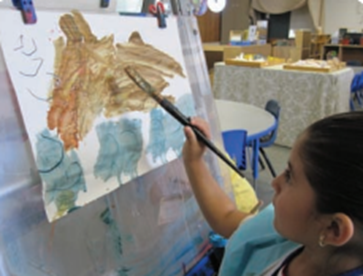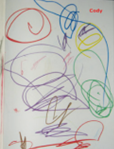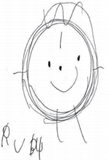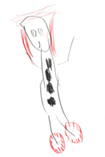11.5: Supporting the Visual Arts
Preschool children often have a natural fascination with the process of creating visual art. Making marks, squishing clay, and using a brush to apply color are activities that attract most young children. In groups where children speak multiple languages and may not share common words, visual art can create connections and a way of communicating. Art can become a way for people to connect across cultures to their common humanity; an appreciation for it may begin in preschool. Inviting families into the environment to share works of art from the home is an opportunity to build a bridge to the home.
Young children are naturally creative. The visual art framework is designed to encourage creativity; open-ended projects emphasize the process of working with visual materials. In other words, the curriculum is not focused on encouraging a child to produce, for example, a specific painting, but rather to practice using a brush on paper without a set outcome.

Children are both consumers and creators of visual arts, which is reflected in the foundations:
Visual Art
1.0 Notice, Respond, and Engage
| At around 48 months of age | At around 60 months of age |
| 1.1 Notice and communicate about objects or forms that appear in art. | 1.1 Communicate about elements appearing in art (such as line, texture, or perspective), and describe how objects are positioned in the artwork. |
| 1.2 Create marks with crayons, paints, and chalk and then identify them; mold and build with dough and clay and then identify them. | 1.2 Begin to plan art and show increasing care and persistence in completing it. |
| 1.3 Enjoy and engage with displays of visual art, inside or outside the classroom. Begin to express preferences for some art activities or materials. | 1.3 Enjoy and engage with displays of visual art. May expand critical assessment of visual art to include preferences for types of artwork or art activities. |
| 1.4 Choose own art for display in the classroom or for inclusion in a portfolio or book and briefly explain choice. | 1.4 Choose own art for display in the classroom or for inclusion in a portfolio or book and explain her or his ideas in some detail. |
2.0 Develop Skills in Visual Art
| At around 48 months of age | At around 60 months of age |
| 2.1 Make straight and curved marks and lines; begin to draw rough circle shapes. | 2.1 Draw single circle and add lines to create representations of people and things. |
| 2.2 Begin to create paintings or drawings that suggest people, animals, and objects. | 2.2 Begin to create representative paintings or drawings that approximate or depict people, animals, and objects. |
Developmental Sequence of Drawing
When provided with tools and a supportive environment, children from ages three to five progress more rapidly in the visual arts than during any other two-year period prior to adulthood. Creativity and imagination are at their apex at age four-and-a-half years; most experienced preschool teachers will attest to this. The arts are a natural outlet for the creative thinking of a preschooler, and learning is rapid.
The progression of children’s drawing ability is the most documented in the visual arts. When children are given a means and a place to make marks, they begin with series of vertical lines and move on to mandalas (i.e., repeated circles). The mandalas soon sprout legs and arms, then faces, and more detailed features such as hair, fingers, or eyes. Harvard University Professor Howard Gardner refers to this process as “the birth of the potato person.” This research has become so well-known that medical doctors will now check on children’s intellectual progress by asking the child and parent how detailed the child’s human-figure drawings are (rather than asking about letters and numbers) at the four-year and five-year checkups. Because children speak multiple languages and progress differently around writing skills, the question about drawing is more relevant and telling for this age group.
Developmental Sequence of Drawing
When provided with tools and a supportive environment, children from ages three to five progress more rapidly in the visual arts than during any other two-year period prior to adulthood. Creativity and imagination are at their apex at age four-and-a-half years; most experienced preschool teachers will attest to this. The arts are a natural outlet for the creative thinking of a preschooler, and learning is rapid.
The progression of children’s drawing ability is the most documented in the visual arts. When children are given a means and a place to make marks, they begin with series of vertical lines and move on to mandalas (i.e., repeated circles). The mandalas soon sprout legs and arms, then faces, and more detailed features such as hair, fingers, or eyes. Harvard University Professor Howard Gardner refers to this process as “the birth of the potato person.” This research has become so well-known that medical doctors will now check on children’s intellectual progress by asking the child and parent how detailed the child’s human-figure drawings are (rather than asking about letters and numbers) at the four-year and five-year checkups. Because children speak multiple languages and progress differently around writing skills, the question about drawing is more relevant and telling for this age group.




The painting progress of children is not as well-documented as their drawing progress. In general, children begin by simply experimenting with brushstrokes and the process of applying paint to a surface. Children’s first paintings are usually solid sections of a single color, two colors, or three colors at the most. The brushstrokes begin to change directions, and shapes emerge. Finally, children begin to attempt representational paintings. The subject matter of such paintings varies depending on the child, the teacher, and the environment.[1]
Teachers can support children’s development of the visual arts foundations with the following:
- Encourage engagement with art at all levels.
- Support exploration and discovery.
- Give children the time and space needed to explore creativity.
- Provide a comfortable environment in which children can practice art.
- Provide opportunities for children to reflect on their own work.
- Respect individual developmental, cultural, and linguistic differences, and encourage children to respect them.
- Provide children simply with a means and place to make marks (e.g., a crayon and paper), and they will begin with the same basic images.
- Encourage communication around shape and form to aid children’s drawing skills.
- Help children acquire painting skills through practice with the tools.
- Stimulate children’s interest in color and application of paint through other forms of painting.
- Create opportunities for children to work with dough, clay, or wet sand.
- Provide only the malleable material, without tools, during children’s initial explorations of sculpting so that children have a chance to explore through touch.
- Communicate to a group of linguistically and culturally diverse children through sculpture techniques by using nonverbal methods.
- Introduce tools after observing that children have had many “hands-on” opportunities to explore clay and dough sculpture.[2]

Table 11.2: Suggested Materials for Visual Art
| Type of Materials | Examples of Materials |
|---|---|
| Found or Recycled Materials | Old magazines for cutting and assemblage, toilet paper and paper towel rolls |
| Basic | Tempera paints, construction paper, chunky crayons, tray watercolors |
| Enhanced | Tube watercolors and palette; watercolor paper |
| Natural Environment | Sticks, rocks, and pinecones for sculpture; clay and natural materials for pressing |
| Adaptive Materials | Thicker handles on some materials; easel that can be adjusted to an appropriate height |
Vignettes
Ms. Cheng is showing children how colors can be mixed to create other colors. While pouring some yellow paint on the plate, she says “What is this color?” “Yellow!” shout the children. Knowing that some children speak other home languages, Ms. Lin asks “Milagros, how do you say yellow in Spanish?” “Amarillo,” Milagros answers. “Samantha, how do you say yellow in Mandarin?” “Huang!” Samantha answers. Ms. Cheng pours out some blue paint and asks the same set of questions. As she moves on to mix the two colors, they turn into green. This time, without prompting, some children shout, “Green!” others say, “¡Verde!” and others say, “Lu!”
It is springtime. The children have returned from a walk outdoors with handfuls of yellow flowers. The teacher places the flowers in a cup in the middle of the painting area and asks the children the color of the flowers. Then he asks, “What shapes do you see in the flower?” The children say, “Circles!” “Lines!” “Squares!” The teacher says, “Really? Where?” The children point at different parts of the flower. The teacher brings out brushes and paint and asks the children if they would like to paint the flowers.
Many of the children sit down and begin to work with the materials, producing all kinds of images. When a child has too much paint on the brush, the teacher assists in showing the child how to wipe paint from the brush on the side of the paint container. As the children finish, the teacher encourages the children to talk about their paintings and then places them in the drying area. Some children finish quickly, and others become absorbed and work for a very long time. Some want to try several times on new paper. A few children attempt to represent the flowers in their paintings, and others experiment with the movement of the brushes and the mixing of color on the paper.[4]
- The California Preschool Curriculum Framework, Volume 2 by the California Department of Education is used with permission ↵
- Ibid ↵
- ibid ↵
- Ibid ↵

